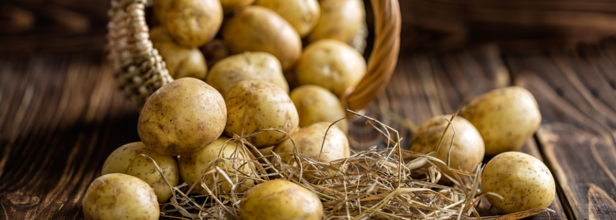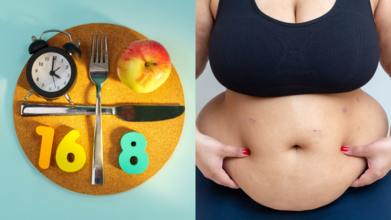- Health Conditions A-Z
- Health & Wellness
- Nutrition
- Fitness
- Health News
- Ayurveda
- Videos
- Medicine A-Z
- Parenting
- Web Stories
Do Potatoes Have Any Nutritional Value?

Credits: Canva
In the dieting world, potatoes often have a bad reputation, as it leads to weight gain or blood sugar spikes. But are potatoes really that unhealthy?
The Potato-Only Experiment
In 2010, Chris Voigt, the then executive director of the Washington State Potato Commissions proved how nutritious potatoes are. In 60 days he ate only potatoes and around 20 per day. He consumed somewhere between 1600 to 2200 calories on a daily basis with minimal oil and seasoning.
The results? He lost around 9.5 kg and his cholesterol and blood sugar levels also improved. He was able to prove his point: potatoes are packed with enough nutrients to sustain life for an extended period without negative health effects.
Could it be an athlete's choice?
Potatoes are popular not just in traditional diets, but also within the fitness community. Mark Taylor, the 2023 Mr. Universe Masters Over 45 champion, attributes much of his success to a carbohydrate-rich diet that includes both white and sweet potatoes. Taylor had increased energy and muscle fullness after switching from a high-protein diet to one high in whole carbohydrates. "People don't believe they need carbs for bodybuilding, but this is the most successful I've ever been," according to his instructor.
So are Carbs your Friends or Foe?
Carbohydrates are generally associated with weight gains and health problems, however there are many studies that suggest that the unprocessed carbs found in potatoes can in fact be beneficial. A 2022 study published in Diabetes Care found that high vegetable consumption, including boiled potatoes, was linked to a 21% lower risk of type 2 diabetes. Similarly, a 2023 study in BMC Medicine showed that high-fiber, whole-grain carbohydrates help lower the risk of cardiovascular disease.
ALSO READ: A Friend Or An Enemy: Can Potatoes Help In Your Weight Loss Journey?
As per experts, fiber-rich foods slow digestion and help maintain stable blood sugar, which is why eating potato while its fiber is still intact is better than consuming the processed version of the potato in forms of fires or chips. Dieticians also highlight the importance of fiber-rich foods such as sweet potatoes, oats, and brown rice, emphasizing that they provide essential vitamins and minerals while being low in fat.
So, should you be eating potatoes?
While Voigt's potato-only diet supported his argument, such a restrictive diet is not suggested for long-term health. The so-called "potato hack" claims to help you lose weight quickly by limiting your diet to simple potatoes for three or five days. Potatoes include critical nutrients such as vitamin C, potassium, and iron, but lack the protein and good fats required for a balanced diet.
Potatoes are not toxic. When cooked in a healthy manner—boiled, baked, or roasted without butter, cheese, or frying—they may be an excellent accompaniment to a nutritious supper. They provide essential nutrients, are affordable, and can even boost athletic performance. The idea is to eat them whole, avoiding overly processed versions.
So, the next time someone claims potatoes are bad for you, remind them of the science: these small tubers are packed with nutrients!
Harvard Doctor Shares 3 Tips To Lose Belly Fat With Intermittent Fasting

Credits: Canva
Those who have belly fat know it is a war when it comes to shedding that fat. It has been fought with everything, from crash diets to endless crunches, but the stubborn midsection just does not go away. Intermittent fasting is not a diet but a way of timing your meals that could help trim that fat. And according to Harvard-trained gastroenterologist Dr. Saurabh Sethi, there are three best tips to lose belly fat with intermittent fasting. One of these is particularly crucial.
Here is how intermittent fasting, done the right way, might finally come to your rescue.
The 12-12 Kickstart
The idea of fasting can sound intimidating. Skipping breakfast or dinner or going without snacks sounds like punishment. But Dr. Sethi suggests starting simple: “First, start with a 12-12 fasting schedule, which is the mildest option. This approach helps you sleep soundly at night and reduces the likelihood of unhealthy food choices the next day."
What does that mean? You fast for 12 hours (say, 8 pm to 8 am) and eat during the other 12. It is not extreme; you are basically just cutting out late-night snacking and mindless munching. That alone can save you hundreds of calories without you even noticing. Plus, your body finally gets a break from digesting round-the-clock, which helps regulate insulin and metabolism.
Sip Smart During the Fast
If you think fasting means surviving on air, you are wrong. Dr. Sethi is clear: “Second, during your fasting window, only drink black coffee, green tea, black tea, water, apple cider vinegar, lemon water, fennel or basil water, chamomile or ginger tea."
In other words, hydration is key. These drinks not only keep you from feeling bloated but also help curb hunger pangs. Black coffee can give your metabolism a gentle push, while herbal teas like chamomile or ginger soothe your system and reduce bloating. Flavoured waters (lemon, fennel, basil) keep things interesting and refreshing. The trick is: no sugar, no milk, no additions. Pure, clean liquids only.
Why does this matter? Because breaking your fast with a sugary coffee or fruit juice is like trying to lose weight while eating cake for breakfast. Staying disciplined with what you sip makes intermittent fasting effective.
Build a Plate That Works Harder Than You
Fasting is not a free pass to eat pizza and pastries during your eating window. Dr. Sethi emphasises: “Third, focus on a high-fibre, high-protein diet during your eating window. High-protein foods like paneer, tofu, chickpeas, chicken, turkey, and fish, and high-fibre foods like fruits and veggies. This combination will keep you full and satiated while promoting fat loss."
Protein helps repair and build muscle while keeping you fuller for longer. Fibre slows digestion, keeps blood sugar stable, and gives you that lovely “I’m full, I don’t need dessert” feeling. Together, they form a dynamic duo that not only supports fat loss but also makes fasting easier because you won’t be ravenous when the clock says “no food”.
Intermittent fasting will not melt belly fat overnight, and you still need to eat mindfully. But when done consistently, it can create a calorie deficit, improve metabolic health, and reduce cravings that hamper your goals. And you do not have to cut out entire food groups or live with greens. You just have to learn when to eat, what to sip, and how to build your plate.
RFK Promotes Full-Fat Milk Over Whole Milk, What's The Health Factor?

Credits: AP, Canva
For nearly 50 years, the U.S. government has urged Americans to avoid whole milk. The shift began in the late 1970s, when rising rates of obesity and heart disease led to strict recommendations: drink low-fat or skim milk, limit cheese, and keep saturated fat to a minimum. These guidelines became official in 1980, shaping what schools served, what food aid programs provided, and even how families stocked their refrigerators.
Now, that long-standing stance may soon change.
Kennedy Pushes for a Policy Reversal
Health and Human Services Secretary Robert F. Kennedy Jr. has repeatedly argued that full-fat dairy deserves government endorsement. Backed by President Donald Trump, Kennedy is spearheading the “Make Our Children Healthy Again Strategy,” a plan that would allow whole milk in public schools and the Women, Infants, and Children (WIC) assistance program.
The move is part of Kennedy’s broader “Make America Healthy Again” campaign, which encourages eating less processed food and re-examining decades of nutritional advice. Unlike some of his more controversial positions, such as promoting raw milk or questioning vaccines, this proposal has mainstream support. Dairy farmers, nutritionists, and even some public health experts agree the science on dairy fat may have been misunderstood.
Is Whole or Skim Milk Healthier?
For decades, the case against whole milk rested on one concern: saturated fat. Experts feared it clogged arteries, contributed to diabetes, and drove obesity rates higher.
But the evidence has never been airtight.
Randomized trials have not proved that low-fat milk is healthier than whole milk, while newer research suggests dairy fat may actually help regulate blood sugar, improve satiety, and slow digestion.
A 2020 meta-analysis of 28 studies found mixed results, in most, children who drank whole milk were less likely to be overweight, but in others, milk type made no difference. Some researchers now argue the distinction between whole and low-fat dairy may not matter as much as once thought.
Read: Why Does RFK Want Whole Milk To Return To Schools?
As cardiologist Dariush Mozaffarian of Tufts University put it: “Dairy fat was given a wrongful conviction in 1980. Forty-five years later, that wrongful conviction might be overturned,” as reported by the Washington Post.
What Health Organizations Still Say
Despite shifting research, most health authorities continue to recommend low-fat dairy for children over age two and for adults. Their advice remains consistent: limit saturated fat to under 10 percent of daily calories (or 6%, in the case of the American Heart Association).
U.S. Dietary Guidelines for Americans: Whole milk for toddlers; skim or 1% for older children and adults.
American Heart Association: Whole milk for toddlers; skim, 1 percent, or 2% for older groups.
American Academy of Pediatrics: Whole milk for toddlers unless obesity risk is high; skim or 1% afterward.
World Health Organization: Breastfeeding preferred for infants; whole milk acceptable for older babies; saturated fat capped at 10% of daily intake.
This gap, between official recommendations and newer research, is at the heart of Kennedy’s push.
Industry Support for Whole Milk
Dairy groups have lobbied for years to bring back whole milk in schools and food programs. Producers argue consumers are already shifting toward higher-fat products as newer studies cast doubt on the dangers of dairy fat.
“It’s time for federal nutrition policy to catch up with the science,” said Andrew Jerome of the International Dairy Foods Association to the Post. The National Milk Producers Federation has also pressed the government to give families more choice.
Sales trends reflect this change: while 2% milk remains the most popular, whole milk consumption has been climbing slowly over the past decade.
Also Read: 5 Cow’s Milk Substitutes—And What To Look For Before You Buy
The Politics Behind Milk
Kennedy has criticized the current dietary guidelines as “antiquated” and too lengthy, promising to replace the 149-page report with a shorter version focused on whole foods. He has also called for re-elevating milk, cheese, and yogurt as central to children’s health.
The Trump administration’s upcoming dietary guidance is expected to highlight whole milk as a healthy choice, though it has remained silent on flavored milks like chocolate or strawberry. These remain available in reduced-fat varieties, despite concerns over high sugar content.
Critics, however, caution against rushing to rewrite policy. Erin Ogden of the Center for Science in the Public Interest warned and told the Post that saturated fat is still linked to health risks: “There hasn’t been enough evidence indicating that the source of saturated fat changes its impact on the body.”
What Comes Next
Most public schools have been barred from serving whole milk since 2010, when a law signed by President Barack Obama tied lunches to federal nutrition guidelines. The WIC program follows the same rules, restricting families from buying whole milk for children over age two.
That could soon change. If the administration finalizes Kennedy’s proposals, both school lunches and WIC benefits may once again include whole and 2 percent milk. Kennedy has pledged to complete an overhaul of the dietary guidelines by the end of the year.
“The attack on whole milk and cheese and yogurt has gone on for decades,” Kennedy said recently. “It’s time to elevate those products to where they belong in contributing to the health of our children.”
Creatine: Bodybuilder's Favorite Supplement Is Now Becoming Workaholics' Go-To

Credits: Canva
Creatine, long hailed in bodybuilding circles as a must-have for muscle strength and growth, is now making waves far beyond the gym. Social media influencers, health podcasters, and even physicians are touting its potential benefits for brain health, hormonal balance, and healthy aging—prompting busy professionals and workaholics to take notice.
But while research strongly supports creatine’s athletic benefits, evidence for its wider applications remains mixed. Here’s what science says.
What Exactly Is Creatine?
Creatine is a naturally occurring compound produced in the kidneys and liver from amino acids. It fuels short, explosive movements by rapidly recycling energy in muscles. Around 95% of the body’s creatine is stored in skeletal muscle, with the rest in the brain, liver, kidneys, and heart.
Our body produce about one gram of creatine daily, while the rest must come from diet. Meat and fish are the richest sources, 225 grams of beef or salmon can provide up to 2.5 grams. This makes supplementation particularly beneficial for vegetarians, who often have lower baseline creatine levels.
Experts suggest three to five grams daily to maintain optimal muscle stores.
Proven Benefits in the Gym
Creatine’s reputation was cemented in 1992 when a landmark study confirmed that supplementation with creatine monohydrate boosts muscle creatine without harmful side effects. Since then, hundreds of studies have shown it helps athletes perform better and recover faster.
By extending the body’s energy system during high-intensity efforts, creatine allows athletes to push harder—whether it’s sprinting, lifting heavy weights, or powering through explosive moves.
A 2024 meta-analysis found that adults under 50 who combined creatine with resistance training gained significantly more strength than those who only trained. On average, lifters on creatine added an extra 4.4 kg to upper-body lifts and 11.3 kg to lower-body lifts.
However, most of these benefits were observed in men, with research in women still limited.
Brain Health and Beyond: Hype or Hope?
The new surge in interest stems from claims that creatine supports cognitive function and women’s health.
A 2003 clinical trial suggested creatine improved working memory and processing speed, sparking speculation that it could benefit older adults or those with demanding mental workloads. More recent reviews, including one in Frontiers in Nutrition, published in 2023, found moderate evidence of improved memory and faster information processing, though no significant improvements in overall accuracy.
Women’s health is another frontier. Some studies hint that creatine could help during pregnancy or menopause, when hormonal fluctuations affect energy metabolism. A review in the Journal of the International Society of Sports Nutrition linked low dietary creatine intake with higher risks of menstrual irregularities and pelvic disorders. Still, experts caution that most findings come from small or association studies, not large-scale clinical trials.
The supplement is also being explored for its role in blood sugar regulation and type 2 diabetes, but current evidence remains speculative.
How to Take It Safely
The Australian Institute of Sport recommends sticking to creatine monohydrate, the form backed by 99% of research. It is widely available, affordable, and easy to mix into water or shakes.
Most evidence supports a daily dose of three to five grams, which saturates muscle stores after about four weeks. For faster results, some use a “loading phase” of 20 grams daily for five days, followed by maintenance dosing.
While higher short-term doses may be needed for potential brain benefits, the optimal amount for cognitive support remains unclear.
Side Effects and Risks
Creatine is generally considered safe, with few reported side effects. Some users may experience stomach upset or water retention, particularly with large doses.
Concerns about kidney or liver damage have been largely debunked in healthy individuals. That said, experts recommend buying from trusted brands to avoid poor-quality supplements that could increase digestive issues.
Interestingly, up to 30% of people may see no noticeable benefits from creatine supplementation at all—a reminder that individual response varies.
Creatine’s transformation from a muscle-builder’s secret weapon to a potential “workaholic supplement” highlights how quickly wellness trends spread in the age of social media. While its benefits for athletic performance are firmly established, claims about brain health, hormonal balance, and blood sugar support remain promising but unproven.
© 2024 Bennett, Coleman & Company Limited

